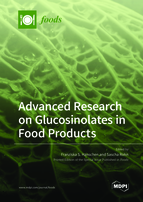Advanced Research on Glucosinolates in Food Products
A special issue of Foods (ISSN 2304-8158). This special issue belongs to the section "Food Physics and (Bio)Chemistry".
Deadline for manuscript submissions: closed (10 September 2021) | Viewed by 41179
Special Issue Editors
Interests: sulfur-containing plant metabolites; biochemistry and chemistry of glucosinolates and products; epithionitriles; isothiocyanates; food processing
Interests: food proteins; secondary plant metabolites; compound stability and interactions
Special Issues, Collections and Topics in MDPI journals
Special Issue Information
Dear colleagues,
Glucosinolate-rich foods such as Brassicaceae vegetables and derived products are valued for their health-beneficial properties. While glucosinolates themselves are only precursor compounds, their enzymatically or chemically formed breakdown products are principals that can have positive effects on human health. Consequently, it is important to focus not only on total amount of (intact) glucosinolates, but also to take into account their derived products present in Brassicaceae-based foods in order to increase the value of those products.
The objective of this Special Issue is to unravel the impact of the whole food supply chain, food production as well as domestic food preparation, on glucosinolates and the formation and chemistry of their breakdown products in vegetables and further food products, including functional foods.
You are cordially invited to submit review articles and original research papers related to the impact of the food supply chain and food preparation on the (bio)chemistry and stability of glucosinolates and their products, including research on the identification of new glucosinolate-derived compounds present in foods. Studies on the functional characterization of glucosinolate-rich food products are welcomed as well.
Best regards,
Dr. Franziska S. Hanschen (the avatar is photoed by Fabian Zapatka)
Prof. Dr. Sascha Rohn
Guest Editors
Manuscript Submission Information
Manuscripts should be submitted online at www.mdpi.com by registering and logging in to this website. Once you are registered, click here to go to the submission form. Manuscripts can be submitted until the deadline. All submissions that pass pre-check are peer-reviewed. Accepted papers will be published continuously in the journal (as soon as accepted) and will be listed together on the special issue website. Research articles, review articles as well as short communications are invited. For planned papers, a title and short abstract (about 100 words) can be sent to the Editorial Office for announcement on this website.
Submitted manuscripts should not have been published previously, nor be under consideration for publication elsewhere (except conference proceedings papers). All manuscripts are thoroughly refereed through a single-blind peer-review process. A guide for authors and other relevant information for submission of manuscripts is available on the Instructions for Authors page. Foods is an international peer-reviewed open access semimonthly journal published by MDPI.
Please visit the Instructions for Authors page before submitting a manuscript. The Article Processing Charge (APC) for publication in this open access journal is 2900 CHF (Swiss Francs). Submitted papers should be well formatted and use good English. Authors may use MDPI's English editing service prior to publication or during author revisions.
Keywords
- glucosinolates
- isothiocyanates
- plant matrix
- food preparation
- Brassica
- epithionitriles
- nitriles
- leaching
- functional characterization








